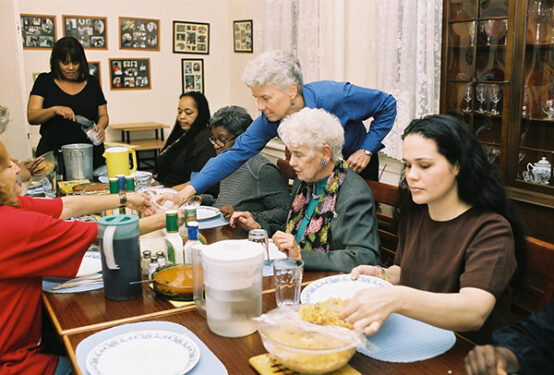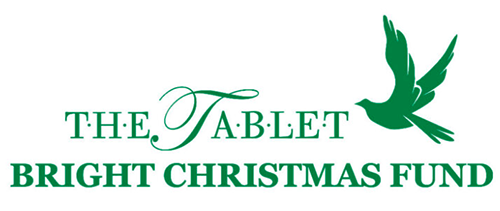PROSPECT HEIGHTS — For more than 40 years, Providence House has helped better the lives of hundreds of individuals and families with the services they offer. And last year, they had a partner in one of their special efforts.
That partner was The Tablet’s Bright Christmas fund, which helped Providence House make the holiday brighter for the women and children to whom they minister throughout the year.

The mission of Providence House is an essential one: to provide homeless family members the transitional housing where values-based rebounds can start, complete with an array of programs — case management, child development coaching services, employment services, and help in the search for long-term housing.
[Related: Bright Christmas Fund 2021: Reflecting on the Past Year]
The story of Providence House is an inspiring one. It began in 1979 when four Sisters of St. Joseph offered a mother coming out of prison a place to stay where she could reunite with her young child.
One of the four, Sister Elaine Roulet, a beloved presence at the Bedford Hills Correctional facility, saw that many women she ministered to at the prison had nowhere to go once they were released. This inspired her to help provide an environment revolving around four core values: community, compassion, hospitality, and non-violence.
“What strikes me most about this organization is that it’s Brooklyn-born and bred — and that it started with just one location where the sisters invited women who were returning from prison and reuniting with their children to stay in the convent,” explained Scott Stepp, Providence House director of development and communications.
“We have grown over the years and responded to a lot of changes in the city, including the growing numbers of homeless in the ’80s, the need for new challenges like chronic homelessness, people struggling with mental illness, and criminal justice programming,” Stepp added.
Today, Providence House serves nearly 600 people housed in 10 residence buildings, including families escaping domestic violence, women with addiction issues that lead to incarceration, and individuals who simply need a safe, supportive environment where they can work toward stability.
According to Stepp, Providence House provides alternatives to detention, residences “where more women and families are spared the experience of Riker’s Island, for instance, and the separation that that causes.”
The goal was to create an environment that would directly counter the types of situations that residents had experienced before, either in prison, in homeless shelters, or on the street. “Providence House provided these individuals with a place where they could start fresh with individual human dignity,” Stepp said.
“And it continues today, where our buildings are much more homelike than you might expect. They blend into the neighborhood.” For example, he referred to “two beautiful brownstones” that became occupied last year. “They are landmarked in the historic district of Bed-Stuy.”
Stepp expressed gratitude to donors like The Tablet’s Bright Christmas fund for its support in helping his organization expand and serve even more needy individuals. Bright Christmas is a tradition that began more than a half-century ago, with the goal of ensuring that no child goes without a gift on Christmas.
Last year, The Tablet raised more than $106,000 for diocesan and parish-based groups, as well as religious education programs. Grass-roots groups have requested resources they can pass along to others and to organizations like Providence House. This year, Bright Christmas hopes to raise $115,000.
The campaign has received and distributed more than $1 million over the past decade. This has been used to purchase Christmas presents, food, materials that teach the faith, and other necessities that enhance dignity and joy.
Resources like Bright Christmas have helped Providence House maintain high-quality services that ease transitions for family members.
“We do know that historically the women who have gone through our Women’s Justice program, for example, end up re-incarcerated at a far lower rate than the general population,” Stepp said.
He cited a few examples of how Providence House has helped make a difference for people.
Henry, a 30-year-old father with a one-year-old daughter, receives support for a stable apartment environment that “allows him to direct his focus toward building a better future for the two of them,” Stepp explained. “Henry has worked hard throughout the year in therapy and educational groups. In the coming year, he will be engaging with a business coaching service, the first step toward starting a business of his own.”
Charlene, a 23-year-old mother of a 2-year-old and a 3-month-old, was released to Providence House from Rikers Island, allowing the family to avoid separation during a crucial time in their lives. In the new year, she will work with the staff to find an affordable apartment of her own.
Shelly entered the Providence House Women’s Justice program after being released from Rikers Island. She recently moved out of a Providence House residence, equipped with a college scholarship and a long-term lease on an affordable home.
Stepp also thanks The Tablet for spearheading the annual Bright Christmas campaign.
“It’s a revered publication, and it’s important to have it in Brooklyn. While so many publications have folded through the years, it’s great to have that kind of continuity in the diocese,” Stepp said. “And we really appreciate the donations because, after all, it allows us to continue to do the job that we do.”

